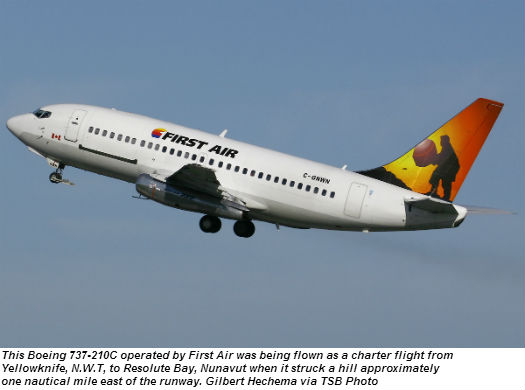TSB Press Release | March 26, 2014
Estimated reading time 3 minutes, 46 seconds.
During the March 25 release of its
investigation report (A11H0002) into the August 2011 fatal accident involving First Air flight 6560 in Resolute Bay, Nunavut, the Transportation Safety Board of Canada (TSB) called on Transport Canada and the airline industry to reduce unstable approaches that are continued to a landing, and to improve crew communications.
On August 20 2011, a Boeing 737-210C, operated by First Air, was being flown as a charter flight from Yellowknife, N.W.T, to Resolute Bay, Nunavut, when it struck a hill about 1 nautical mile east of the runway. The accident claimed the lives of all four crew members and eight of the passengers, and left three passengers seriously injured.
The investigation concluded that a combination of factors contributed to the accident. The aircraft did not intercept the runway localizer (alignment) beam, and instead diverged to the right, and ultimately hit a hill. Fundamental to the Board’s findings is the fact that an
unstable approach was continued to a landing. “Too many unstable approaches continue to a landing, and this is an international problem,” said board member Joseph Hincke. “If we want to see fewer landing accidents, we have to tackle this issue now.”
Central to the TSB findings was that, although the two pilots were aware they were off course, they each had a different understanding of the situation and did not take corrective action in time. Effective
crew resource management (CRM) training and procedures help crews manage workload in the cockpit and communicate effectively to make better decisions and solve problems.
“Although Transport Canada is taking steps to update the CRM training standards, the Board is concerned that a comprehensive and integrated approach to monitoring and reinforcing best practices is still needed,” added board member Kathy Fox. “To advance aviation safety in Canada, the TSB is seeking stronger defences to reduce unstabilized approaches, and measures to improve crew communications.”
This accident involves one of the issues on the TSB Watchlist: Collisions with land and water. The Watchlist is a list of transportation safety issues that pose the greatest risk to Canadians. In each case, action to date has been inadequate, and concrete steps must be taken on the part of the regulator and industry to eliminate these risks.



